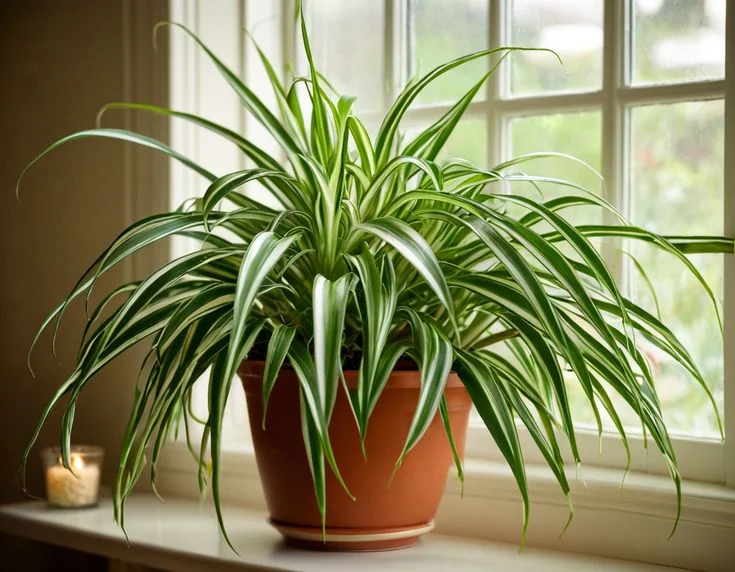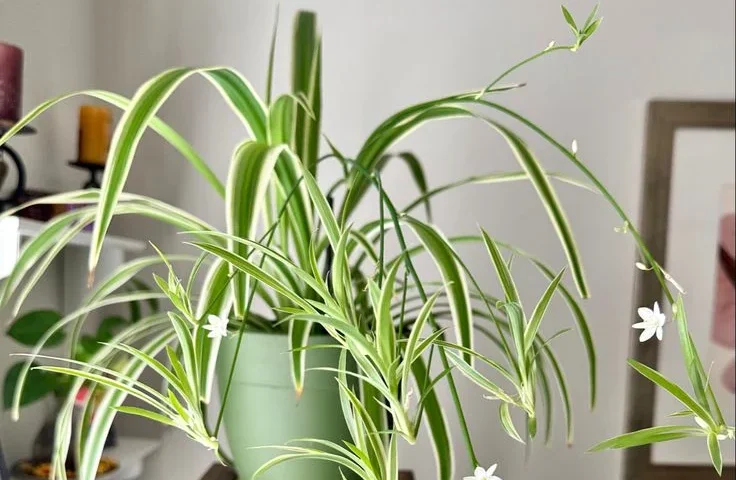Spider plants are one of the most popular indoor plants because of their resilience, low maintenance, and natural air-purifying qualities. If you are wondering how to care for spider plants, this guide provides everything you need to know to keep them thriving.
Whether you are a beginner or an experienced gardener, spider plants are forgiving and adapt well to different environments. However, proper care ensures they remain healthy, vibrant, and full of those iconic arching leaves.
Why Choose a Spider Plant?
Before diving into how to care for spider plants, it’s worth knowing why they are such a beloved choice among indoor gardeners. Spider plants are highly valued for their air-purifying qualities, as studies like NASA’s clean air research have shown their ability to remove harmful toxins such as formaldehyde and carbon monoxide from the air.
In addition, they are extremely low-maintenance, making them perfect for busy plant owners who may forget an occasional watering. Their attractive appearance, with cascading green-and-white striped leaves and tiny baby offshoots called “spiderettes,” brings natural beauty and elegance to any room.
Another reason for their popularity is that spider plants are pet-friendly, meaning they are safe for cats and dogs, unlike many other common houseplants.
Ideal Growing Conditions: How to Care for Spider Plants Indoors

Understanding the ideal growing conditions for spider plants is essential if you want them to stay healthy and vibrant. These hardy houseplants thrive best in bright, indirect sunlight, as too much direct exposure can scorch their leaves, while low light may slow their growth.
They also prefer moderate temperatures ranging between 60–75°F (15–24°C), which makes them perfect for most indoor environments. Another key factor is humidity although spider plants adapt well to average household air, they grow even better in slightly humid spaces such as bathrooms or kitchens.
Pairing the right temperature, light, and humidity with well-draining soil ensures your spider plant flourishes year-round. By recreating these natural conditions indoors, you’ll make spider plant care effortless and rewarding.
Light Requirements
Spider plants thrive in bright, indirect light. Place them near a window where they get filtered sunlight.
- Too much direct sunlight can scorch their leaves.
- Too little light can cause pale or weak growth.
A north- or east-facing window works best. If you don’t have natural light, they also adapt well under fluorescent lights.
Watering Schedule
Watering is where most plant parents struggle. Spider plants prefer soil that is slightly moist but never soggy.
- Water them once a week in summer, allowing the top inch of soil to dry between waterings.
- Reduce watering in winter, as the plant grows more slowly.
Soil Preferences
Spider plants grow well in well-draining potting soil. A mix containing peat, perlite, or sand works perfectly.
This ensures proper aeration and prevents excess water from suffocating the roots.
Temperature and Humidity
Spider plants love moderate growing conditions, which makes them one of the easiest houseplants to maintain. The ideal temperature range for spider plants is 60–75°F (15–24°C), allowing them to thrive in most indoor environments.
However, it is important to avoid sudden drafts or placing them near heaters, as extreme temperature changes can stress the plant and damage its leaves. In addition to temperature, spider plants also appreciate moderate humidity levels.
If your home air is dry, especially during winter, you can mist the leaves occasionally to provide the extra moisture they need. By maintaining the right balance of temperature and humidity, you create the perfect environment for spider plants to flourish.
Fertilizing Tips: How to Care for Spider Plants with Proper Nutrition

For lush green leaves, spider plants benefit from feeding during their growing season.
- Use a balanced liquid fertilizer every 2–3 weeks in spring and summer.
- Avoid over-fertilization, as it can lead to brown leaf tips.
During fall and winter, reduce feeding since the plant’s growth slows down.
Repotting Guide: How to Care for Spider Plants as They Grow
Spider plants grow quickly, and their roots may outgrow the pot. Repotting keeps them healthy.
- Signs of repotting need: roots circling the pot, soil drying out too quickly, or stunted growth.
- Best time to repot: spring.
Choose a pot one size larger than the current one, and refresh with new soil.
Propagation Tips: How to Care for Spider Plants and Multiply Them
One of the most exciting features of spider plants is how easily they can be propagated, making them a favorite among indoor gardeners. These plants naturally produce small offshoots, often referred to as “babies” or spiderettes, which dangle gracefully from the mother plant.
To propagate, simply snip off a healthy spiderette and place it in water or directly into soil until new roots begin to develop. This simple process not only allows you to multiply your spider plant collection but also provides an affordable and thoughtful way to share living gifts with friends and family.
Propagation is truly one of the most rewarding aspects of learning how to care for spider plants.
Common Problems and Solutions

Even though spider plants are hardy and beginner-friendly, they can still face a few issues that every plant parent should know about. The most common problems with spider plants include brown leaf tips, yellowing leaves, and occasional pest infestations.
If you’ve noticed yellowing foliage on your other houseplants too, you might find this guide on peace lily yellow leaves helpful it explains common causes and easy fixes that apply to many indoor plants.
Brown tips often occur due to over-fertilization, low humidity, or fluoride in tap water, while yellow leaves are usually a sign of overwatering. In addition, pests like spider mites or aphids may appear, though they can be controlled with natural remedies such as neem oil or a gentle soap spray.
The good news is that all of these issues have simple solutions, and with the right adjustments, your plant can quickly recover. By understanding these challenges and responding promptly, you’ll make caring for spider plants much easier and ensure long-lasting growth.
-
Brown Leaf Tips
This is often caused by fluoride in tap water, over-fertilization, or low humidity. Use filtered water and cut back on fertilizer.
-
Yellow Leaves
Usually a sign of overwatering. Let the soil dry before the next watering.
-
Pests
Spider plants rarely attract pests, but aphids or spider mites may appear. Wipe the leaves with neem oil or a mild soap solution.
Styling Your Spider Plant
Spider plants look stunning when displayed creatively.
- Hanging baskets: Their arching leaves and spiderettes cascade beautifully.
- Tabletop pots: Add greenery to desks and shelves.
- Bathroom placement: Since they enjoy humidity, they thrive in bathrooms with natural light.
FAQs
What is the best way to water a spider plant?
Water thoroughly once the top inch of soil is dry. Always ensure excess water drains away.
How often should I fertilize spider plants?
Fertilize every 2–3 weeks in the growing season with a balanced liquid fertilizer.
Can spider plants survive in low light?
Yes, they tolerate low light, but they grow best in bright, indirect sunlight.
Why are the tips of my spider plant turning brown?
Brown tips usually result from fluoride in tap water, over-fertilization, or low humidity. Switching to filtered water often helps.
Do spider plants need repotting often?
They should be repotted every 1–2 years when roots outgrow the pot.
Conclusion
Learning how to care for spider plants is simple once you understand their needs. With the right light, proper watering, well-draining soil, and occasional fertilization, your spider plant will thrive and continue to beautify your indoor space. If you enjoy nurturing indoor greenery, you might also like learning how to replant an aloe vera plant for even more easy plant-care inspiration.
Their forgiving nature makes them perfect for beginners, while their air-purifying benefits make them a healthy choice for every home. Plus, propagation ensures you’ll never run out of these charming plants.
For more insights on indoor plant care, you can explore The Spruce’s plant care guide, which offers additional professional tips.


















